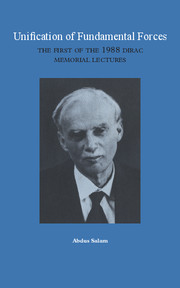Book contents
- Frontmatter
- Contents
- Foreword
- Unification of fundamental forces
- 1 Introduction
- 2 The unifying concepts of physics in the past
- 3 The concept of elementarity and nuclear forces
- 4 The unification of the weak nuclear force with electromagnetism
- 5 The strong nuclear force as a gauge force and the standard model
- 6 Beyond the standard model
- 7 Envoi
- History unfolding: an introduction to the two 1968 lectures by W. Heisenberg and P. A. M. Dirac
- Theory, criticism, and a philosophy
- Methods in theoretical physics
1 - Introduction
Published online by Cambridge University Press: 08 January 2010
- Frontmatter
- Contents
- Foreword
- Unification of fundamental forces
- 1 Introduction
- 2 The unifying concepts of physics in the past
- 3 The concept of elementarity and nuclear forces
- 4 The unification of the weak nuclear force with electromagnetism
- 5 The strong nuclear force as a gauge force and the standard model
- 6 Beyond the standard model
- 7 Envoi
- History unfolding: an introduction to the two 1968 lectures by W. Heisenberg and P. A. M. Dirac
- Theory, criticism, and a philosophy
- Methods in theoretical physics
Summary
I am honoured to speak about P. A. M. Dirac whom we all loved and whom I so greatly admired. I am also glad to see so many friends in the audience. As an old Johnian myself, I would particularly like to mention Sir Harry Hinsley, the Master of St. John's (Dirac's College). Sir Harry is an eminent historian. To him I shall address my remarks, so as to assure you all that you will be spared as many technical details as possible.
Paul Adrian Maurice Dirac was undoubtedly one of the greatest physicists of this or of any century. In three decisive years, 1925, 1926, and 1927, with three papers, he laid the foundations, first of the Theory of Quantum Mechanics, second of the Quantum Theory of Fields, and third — with his famous equation of the electron — of the Theory of Elementary Particles. (In the course of this lecture, I shall explain the relevant concepts of the Quantum Theory of Fields and the Dirac equation for the electron.) When one met Dirac, one could see the complete and utter dedication of a great scientist. One could feel with him the pleasure of scientific creation at its noblest, and the highest personal integrity.
- Type
- Chapter
- Information
- Unification of Fundamental ForcesThe First 1988 Dirac Memorial Lecture, pp. 1 - 5Publisher: Cambridge University PressPrint publication year: 1990



